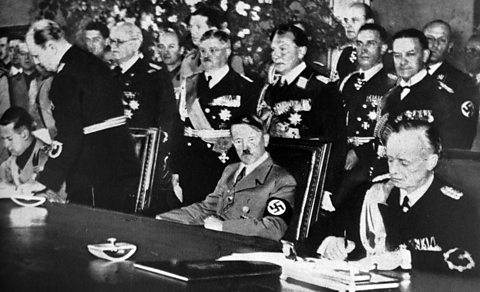The Polish Corridor and the Pact of Steel
It was no surprise that Hitler turned his attention to Poland.
The Treaty of VersaillesThe peace treaty between the Allies and Germany at the end of World War One. had given a number of German areas to the Poles. This included the hated Polish CorridorA strip of land given to Poland under the Treaty of Versailles. It gave Poland a connection to the Baltic Sea. Although free German travel was allowed across the corridor it was a physical barrier separating the former German province of East Prussia from Germany..
German negotiations had begun with Poland for access to the city of Danzig in late 1938. This was a German city which was supervised by the League of NationsAn international organisation where the leaders of countries could settle problems in the hope that they could avoid wars..
On 23 March 1939 Lithuania was forced to hand over the disputed territory of Memel to Germany. Along with the occupation of Czechoslovakia in March 1939 this increased the pressure on Poland.
Germany's Foreign Minister, Ribbentrop, wanted the return of Danzig. He also wanted land links through Poland to East Prussia. The Poles were also asked to join the Anti Comintern PactA alliance between Germany and Japan against Communism. against the USSRUnion of Soviet Socialist Republics - collection of states, also known as the Soviet Union.. The Polish Foreign Minister, Colonel Josef Beck, rejected the demands.
The British and French guarantee to Poland was welcomed. At this point Poland was short of friends. In October 1938 Poland had taken advantage of the Munich crisis to annex the area of Teschen from Czechoslovakia. This behaviour had been criticised by British politicians such as Churchill.
Issues with the British and French guarantee to Poland
- Poland had been ruled by members of the Polish military for much of its existence after 1918
- it had signed a non-aggression pact with Germany in 1934
- some critics asked why Britain would support Poland but abandon a democracy like Czechoslovakia.
- Poland was in a weaker position than Czechoslovaki
- the German military had spent the six months after October 1938 improving their strength
- Poland was located between Germany and the USSR - critics asked what support Britain and France could actually provide
Pact of Steel
The Pact of SteelA military and political alliance between the Kingdom of Italy and Nazi Germany. was signed between Germany and Italy in May 1939. Unlike the Anti Comintern Pact it was a formal alliance. It meant that Italy and Germany would support each other in the event of a war. This improved Hitlerās position.
The Italian dictator Mussolini had been less than keen to commit to the Pact. This was because he did not believe that Italy was ready for a major war.
The pact increase belief among the Soviets that they were facing an increasing threat from the Fascist powers.
